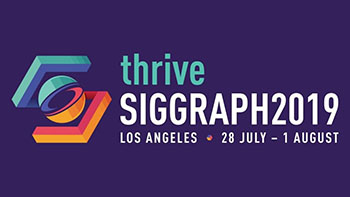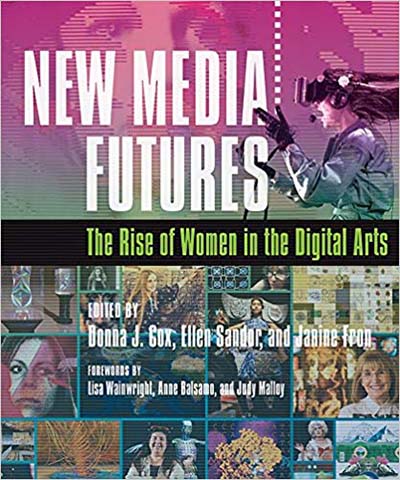
Logo for the annual meeting of the computer graphics community, which includes academic, commercial and fine arts practitioners of computer graphics and interactive techniques, as well as hardware and software makers.
The field of computer graphics has no single bigger event than the annual SIGGRAPH conference, a 5-day extravaganza that draws computer scientists, visual effects artists, hardware and software designers and thousands of practitioners in the arts and sciences from around the world.(1) The 2019 conference in Los Angeles, which wrapped up on Thursday, August 2, hosted a number of talks highlighting the stories of women working in computer graphics as part of the “ACM SIGGRAPH Diversity and Inclusion Summit.” One exciting panel, “HERstories: Women Leaders in the Digital World,” featured 12 women who are seminal figures in computer-entangled fine arts, many of whom began their work in the early 1980s. The panelists were all contributors to a recent book, edited by Donna J. Cox, Ellen Sandor, and Janine Fron, New Media Futures: The Rise of Women in the Digital Arts (Champaign: University of Illinois Press, 2018). The panel and the book are welcome additions to the slowly diversifying histories of computer graphics, computer art and SIGGRAPH.
Rediscovering Lost Narratives
Women computer artists, hardware and software designers, and academic researchers, have been hard at work since the early days of the field, innovating and collaborating in advancing the art and science of computer graphics (CG). But over the past decade, as historians of technology have begun to detail the histories of computing, computer programming, and the lives of individual pioneers in CG, the contributions of women have been largely overlooked. While some recent research has addressed women in technology, fine arts, and the digital arts (Malloy 2013), New Media Futures focuses on the work of fine artists working in the midwestern United States from the 1970s-1990s, and brings to life the varied landscape of media arts in the “Silicon Prairie.”

Book cover of the hardcover edition of New Media Futures, published in late 2018.
As an educator teaching the history of CG to engineering students, I encountered young women in my classes, eager to learn about women in the field, but I found few published resources for them. This book will help to fill that void. Cox, Fron, and Sandor, all practitioners in the field, have collected 22 stories from artists working in representational and abstract genres with digital painting, digital photography, computer animation, computer games, virtual reality, performance art, and many related digital media forms. The book is an oversized treat, with abundant references, a helpful guide to terms, an index, and is richly-illustrated with photographs of art, artists and their working environments. Forwards by Lisa Wainwright, Anne Balsamo, and Judy Malloy make the case for why this book is a particularly timely addition at this moment of recalibration—as we begin rethinking how we present the stories of women in technology and the arts, and the pressures on the early adopters of computer art technologies. Several of the authors describe being overlooked by traditional art curators and being sidelined in the male-dominated hardware and software fields. Wainright notes, “Not only was it challenging to jostle for a place in the patriarchal system of the art world, it was also equally daunting to participate in the arena of scientific technologies as a woman.”(2) Some names in the book will undoubtedly be familiar to those who follow the digital arts, while others will be a revelation. The introduction puts them all in context, with a concise history of computer art and the computer’s evolution as an interactive, expressive tool. The book is divided into three main themed sections: art/science collaborations, the aesthetics of new media and the influences the women have had on Each chapter features an individual artist’s biography and essay describing their work over the years.
Revisiting the “Silicon Prairie”
The authors chose to focus on women with roots in the midwestern United States, and several of the authors have connections to academic institutions and visualization labs in and around Chicago. Cox, director of the University of Illinois’ Advanced Visualization Laboratory at the National Center for Supercomputing Applications, pioneered the idea of interdisciplinary “Renaissance Teams,” to tackle complex visualization problems. Cox points to what she describes as the, “…cocreative, collaborative spirit,” that infuses her own work. The theme of creativity fostered by networks and collaborations runs throughout the book, which makes the case for the widening influence of the midwest as a number of artists moved to the East and West coasts to work and teach. Through the artist’s narratives, New Media Futures traces the outlines of the silicon prairie, and its role in shaping our current digital media landscape, describing their work over the years.
Conclusions
New Media Futures will be a rewarding read and a prized possession for scholars interested in the experimental, creative spaces for art carved out by women working between the coasts. Visual anthropologists and other CASTAC readers may be particularly interested in the images that detail early working conditions, including the Plato computer, pre-virtual world interactive interfaces, and drawing with a Datamax UV-1 and Epson tablet.(3)
The many images from the artists’ own collections, and stories told in their own words make this lively and engaging volume a welcome addition to the literatures on women’s history, the histories of computing, and the digital media arts.
References
Cox, Donna J., Ellen Sandor, and Janine Fron, Eds., New Media Futures: The Rise of Women in the Digital Arts (Champaign: University of Illinois Press, 2018).
Malloy, Judy, Ed., Women, Art and Technology (Cambridge, MA: The MIT Press, 2003).
Notes
(1) ACM SIGGRAPH is the acronym for the Association for Computing Machinery, Special Interest Group Graphics. The Association for Computing Machinery (ACM) was the first computer society, founded in 1947, at the dawn of the computer age. SIGGRAPH, founded in 1974, is a SIG or special interest group which has taken on a life of its own, hosting large annual conferences. An estimated 18,700 practitioners of digital arts and interactive media attended the 2019 conference, held in Los Angeles, California.
(2) Wainright, in Donna J. Cox, Ellen Sandor, and Janine Fron, Eds., New Media Futures: The Rise of Women in the Digital Arts (Champaign: University of Illinois Press, 2018), p xi.
(3) New Media Futures, pp. 19, 39, 215.
